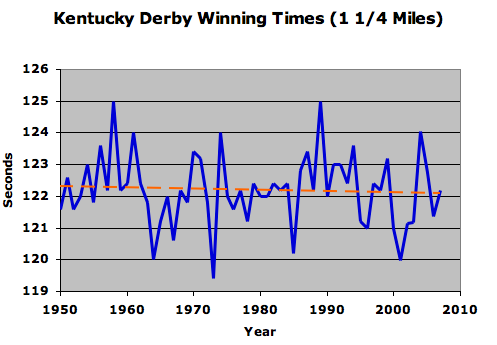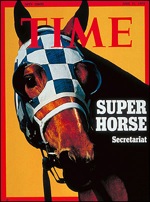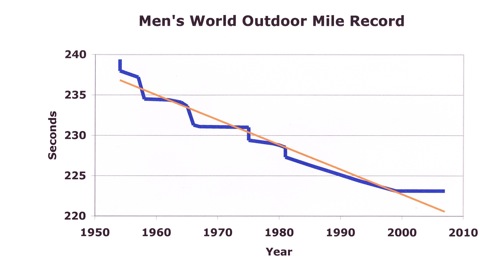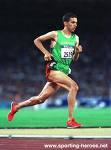Just how well has the Thoroughbred industry fared in improving the breed? In improving racing?
Well, as measured by the racing speed of the Thoroughbred, the industry’s efforts are less than stellar. At least as compared with the progress in running as accomplished by humans.
Look at the results of the Kentucky Derby over the last six decades:

In 1950, Middleground won the Derby in 2:01 3/5 (121.6 seconds on the chart above). In 2007, Street Sense won in a slightly slower time of 2:02.17 (122.17 seconds).
If we look at all the race times in the last 57 years (the blue line), there has been essentially no improvement in speed. The trendline (orange) over this period is virtually flat. Lots of fluctuation around a fairly narrow range, but the ponies simply are not running any faster than they used to.
By the way, the one real outlier in horse-racing in the last century, Secretariat, won in 1973 at a record 1:59 2/5 (119.4 seconds).

So after countless generations of selective breeding of only the “best” with the “best,” after multimillion dollar prices paid at the Keeneland yearling sales for the progeny of the “best” sires and the “best” dams, after great improvements over the years in tracks conditioning, in nutrition, in veterinary, and in training -- the horses still can’t run any faster than they did decades ago! Why not?
My guess is that they have become so inbred, that instead of improving the breed, the opposite has happened. And all of those aforementioned improved techniques are just offsetting the declines in the breed’s capabilities.
In partial support of this argument, let’s look at another animal -- the human. No Jockey Club, no highly regulated industry, no adhering to closely guarded rules as to who may breed with whom, the human is a product of mostly random couplings. The result (along with, to be fair, better training, nutrition, et al.) is remarkable; we just keep getting faster and faster. (The improvement may be asymptotic, but what the hell, it’s still improvement).
Take the almost astonishing progression of the world record in the mile run (plotted over the same time period as the Kentucky Derby chart):

From 1952 to the present, the record time has dropped 18 times for a total of 16 seconds.

The present record, set in 1999, was by Hicham El Guerrouj of Morocco at 3:43.13. Similar trends are the case in almost every other track and field event, as well as in swimming, both men’s and women’s. But that’s the topic for a forthcoming blog, one that doesn’t make horse-human comparisons, but rather man-woman, with at least one surprising observation.